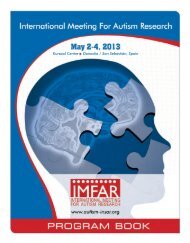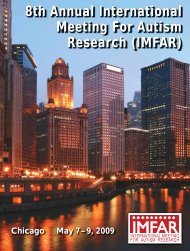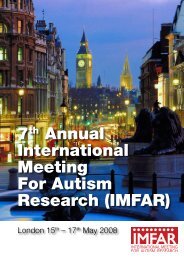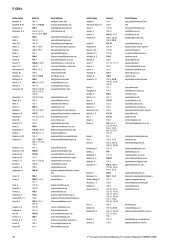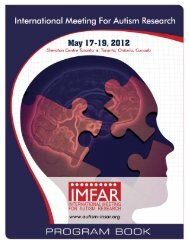9th Annual International Meeting For Autism Research ... - Confex
9th Annual International Meeting For Autism Research ... - Confex
9th Annual International Meeting For Autism Research ... - Confex
Create successful ePaper yourself
Turn your PDF publications into a flip-book with our unique Google optimized e-Paper software.
Program<br />
12:00-1:00P Business <strong>Meeting</strong> (Grand Ballroom F Lvl 5)<br />
1:15-3:15P IES: The Relationship between Epilepsy and <strong>Autism</strong> (Grand Ballroom F Lvl 5)<br />
1:15-3:15P<br />
Oral Session: Developmental Stages, Imitation and Play<br />
(Grand Ballroom E Lvl 5)<br />
Saturday May 22 nd<br />
Oral Session: Treatment 2 (Grand Ballroom AB Lvl 5)<br />
Oral Session: Clinical Phenotype 2 (Grand Ballroom CD<br />
Lvl 5)<br />
Invited Educational Symposium<br />
137 Relationship Between Epilepsy and <strong>Autism</strong><br />
1:15 PM - 3:15 PM - Grand Ballroom F Level 5<br />
Oral Sessions<br />
138 Clinical Phenotype 2<br />
1:15 PM - 3:15 PM - Grand Ballroom E Level 5<br />
Moderator: S. Spence; NIH<br />
This symposium is designed to explore the relationship<br />
between epilepsy and ASD. While higher rates of<br />
epilepsy have long been reported in ASD, prevalence<br />
estimates vary from 5% to as much as 46%. While<br />
variation likely reflects differences in study samples,<br />
several factors appear to truly increase epilepsy risk<br />
such as lower IQ, co-morbid syndromes (e.g. nonidiopathic<br />
autism) and gender. However, the rate<br />
of epilepsy in idiopathic ASD with normal IQ is still<br />
significantly above population risk, suggesting autism<br />
itself is associated with an increased epilepsy risk. The<br />
recent appreciation that epileptiform EEG abnormalities<br />
occur with rates as high as 60%, even in the absence<br />
of epilepsy, has lead investigators to propose they<br />
may play a causal role. We posit that epilepsy and<br />
epileptiform EEGs represent biomarkers of cortical<br />
dysfunction in ASD and believe relationships should be<br />
vigorously explored. This symposium will review clinical<br />
and electrophysiological data and describe the breadth<br />
of association with ASD. Next we will describe a genetic<br />
disease model known to overlap with ASD and epilepsy:<br />
Tuberous Sclerosis Complex (TSC), whose pathways<br />
provide researchers a window into this relationship as<br />
well as novel therapeutic targets. Finally, we discuss<br />
pathophysiological data that characterizes ASD as an<br />
imbalance between neuronal excitation and inhibition,<br />
which in turn suggests possible directions for future<br />
research.<br />
1:15 137.001<br />
EPILEPSY, EPILEPTIFORM EEG AND AUTISM: Who has it and what<br />
might it mean?. M. Chez*, Sutter Neuroscience Institute<br />
1:45 137.002<br />
Magnetoencephalography in ASD: How can new<br />
electrophysiological imaging techniques help explore the<br />
relationship?. J. D. Lewine*, Alexian Brothers Medical Center<br />
2:15 137.003<br />
Tuberous Sclerosis Complex: What can the knowledge of signaling<br />
pathway abnormalities teach us about ASD?. M. Sahin*, Director of<br />
Multi-disciplinary Tuberous Sclerosis Program<br />
2:45 137.004<br />
Excitatation/Inhibition Imbalance in ASD: Is this a<br />
pathophysiological model of cerebral dysfunction in ASD?. T.<br />
Hensch*, Center for Brain Science, Harvard University<br />
1:15 138.001<br />
Pragmatic Language and Social Cognitive Overlap in Children with<br />
<strong>Autism</strong> and Fragile X Syndrome. G. E. Martin*, M. Losh, J. Klusek<br />
and A. Harris, University of North Carolina at Chapel Hill<br />
1:30 138.002<br />
Clinical and Neuropsychological Overlap in the Broad <strong>Autism</strong><br />
Phenotype and the FMR1 Premutation. M. Losh*, G. E. Martin and<br />
J. Klusek, University of North Carolina at Chapel Hill<br />
1:45 138.003<br />
Variants in the Social-Emotional Phenotype of Children with <strong>Autism</strong><br />
and Children with Fragile X Syndrome. N. M. Russo*, E. Berry-<br />
Kravis, C. McKown and M. Lipton, Rush University Medical Center<br />
2:00 138.004<br />
A Comparison of Sleep Patterns and Behaviour in Children with<br />
<strong>Autism</strong>, Other Developmental Disabilities, and Typically Developing<br />
Children. A. L. Richdale* 1 and S. Cotton 2 , (1)La Trobe University,<br />
(2)University of Melbourne<br />
2:15 138.005<br />
Effects of Social and Non-Social Cues On Saccadic Eye Movements<br />
in ASD and ADHD. B. Azadi* 1 , U. Ettinger 2 , P. Asherson 3 , K. L.<br />
Ashwood 1 , S. Cartwright 1 , G. Childs 1 and P. Bolton 1 , (1)Institute of<br />
Psychiatry, King’s College London, (2)Department of Psychiatry,<br />
Ludwig-Maximilians-University Munich, (3)Institute of Psychiatry<br />
2:30 138.006<br />
Personal Space and Interpersonal Distance in <strong>Autism</strong>: Insights<br />
From the SRS. D. P. Kennedy* 1 , J. N. Constantino 2 and R. Adolphs 1 ,<br />
(1)Caltech, (2)Washington University School of Medicine<br />
2:45 138.007<br />
Sex Differences in Autistic Traits: Is High Verbal IQ Protective<br />
against Social Impairments in Girls but Not Boys?. K. Dworzynski* 1 ,<br />
A. Ronald 2 , R. A. Hoekstra 3 , F. Rijsdijk 1 and F. Happé 1 , (1)Institute of<br />
Psychiatry, King’s College London, (2)Birkbeck College, University<br />
of London, (3)University of Cambridge<br />
3:00 138.008<br />
Head Circumference Developmental Course in the First 14 Months<br />
of Life in Children with ASD. A. Narzisi*, T. Filippi, F. Apicella, E.<br />
Santocchi, S. Calderoni, S. Calugi, R. Tancredi and F. Muratori,<br />
University of Pisa – Stella Maris Scientifi c Institute<br />
<strong>9th</strong> <strong>Annual</strong> <strong>International</strong> <strong>Meeting</strong> <strong>For</strong> <strong>Autism</strong> <strong>Research</strong> (IMFAR) 2010 65<br />
Saturday – PM



